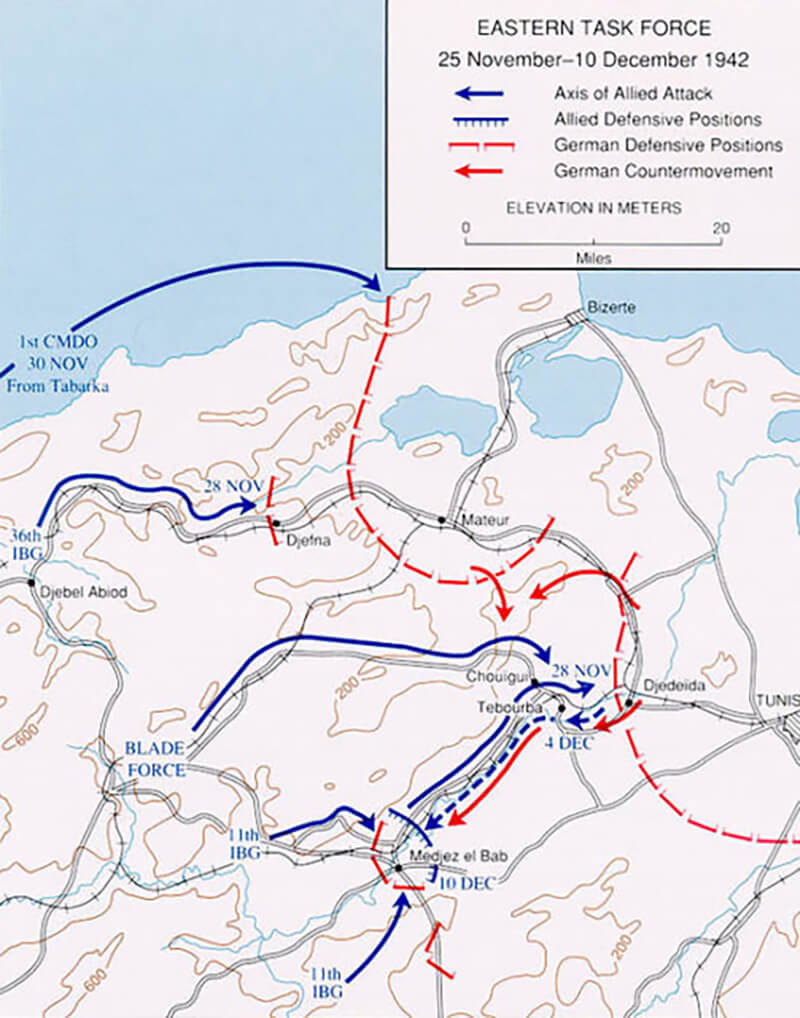| Page Created |
| August 26th, 2022 |
| Last Updated |
| April 16th, 2024 |
| Great Britain |
 |
| The United States |
 |
| Special Forces |
| Commandos U.S. Army Rangers |
| December 1st, 1942 – December 5th, 1942 |
| Operation Bizerte |
| Objectives |
- Seize and hold two Road Junction.
- Deny the road in between the Road Junctions to the enemy.
- Destroy enemy transport.
- Delay and harass enemy forces withdrawing before the arriving of the British 36th Infantry Brigade.
| Operational Area |
Garaet Achkel, Douar Faroudja area in Tunesia.
| Unit Force |
- No. 1 Commando (6 troops)
- U.S. Army Rangers (4 troops)
- Eight donkeys (mortars)
- Nine Landing Craft Mechanised
- Four Landing Craft Assault.
| Opposing Forces |
- German Afrika Korps
| Operation |
| November 30th, 1942 |
17:30. The whole of No. 1 Commando and 4 troops of the U.S. Army Rangers embark nine Landing Craft Mechanised and four Landing Craft Assault at Tabarka Harbour, Tunesia.
18:00. The assault convoy is beginning to form up outside the harbour and heads towards the landing beaches.
| December 1st, 1942 |
01:00. The assault force lands on the beach in the Sidi Ali Chedly area, in two waves. In the first wave half of the Commando Force and a Headquarters land. They are tasked to take up the most easterly positions. This half is under command Lieutenant Colonel T.H. Trevor. The other half of the Commando Force lands in the second wave and is commanded by Major K.R.S. Trevor and takes up the most westerly positions.
03:15. The landings are completed, and the assault convoy returns the base at Tabarka, Tunisia.
The Commando force starts heading for their objectives and move eight kilometres inland. No contact is made with the enemy or with the local inhabitants. Their objectives are now right in front of them. The first group under command of Lieutenant Colonel T.H. Trevor starts moving towards the road junction eight kilometres to the East of it at Douar Faroudja. The second group under command of Major K.R.S. Trevor heads for the road junction where the main route from Bizerte to Mateur round the Northern shores of Garaet Achkel is joined by a Secondary route which runs Westwards some two and a half to five kilometres South of the coast. Both groups are responsible for the road which runs between the two road junctions.
Both groups reach and occupy their objectives. The road Junction in the East is occupied throughout the day. The Commando force is forced to withdraw to the hills close by when the enemy attack by Armoured Fighting Vehicles and Infantry. From within the hills the Commando force is still able to cover the road junction and deny the enemy from using the road.
The main enemy position encountered lay a short way back from the road junction in the West and appears to be fairly well concealed. Its machine gun nests are sighted to give good enfilade fire, and it also disposes of some 2-pounders on concealed tracks. Fire is withheld until the Commando forces are well within an organised network of machine gun fixed lines.
The two Troops of Captain Davidson and Captain Pollitt approach the position closely. Both Troops reach approximate positions in the early afternoon and detach parties to form roadblocks with heavy stones and whatever else they could find to do the work.
One Troop is sent to the aerodrome at Sidi Ahmed, about ten kilometres to the Northeast of Douar Faroudja. They are tasked to keep the airfield under continuous observation. They observe dense enemy air activity on the aerodrome the first day. They witness fourteen bombers arriving from Northeast, picking up fighter escort over the aerodrome and moving away eastwards.
Little did they know that events further west had already made their presence irrelevant.
The 36th Infantry Brigade opened an offensive with infantry and Bren gun carriers to advance along the road. The unit’s role is to clear the Axis forces out of the sector and advance on Bizerte.
As they approach the Green and Bald Hills, the way seems to be clear, since there is no sign of the enemy, they advance down the pass, between the high ground.
Halfway down the pass concealed heavy machine-guns open fire. Ten of their twelve Bren carriers are destroyed. Thirty men were killed and fifty wounded.
The survivors rally but are unable to reach the German positions. At nightfall they retreat, leaving behind eighty-six prisoners.
| December 2nd, 1942 – December 5th, 1942 |
However, for the next three days the Commando Force not only dominates this area and deny the use of the road to the enemy. During those three days the Commando Force occupy an area of some 325 Square Kilometres, inside which they moved with complete freedom. They are able to destroy any enemy transport attempting to use the road between the two road junctions. In addition, the Commando Force forces the enemy to draw on his reserves and to detach a substantial force to counter the threat to his flank and rear.
The Axis forces ambush one of the Ranger platoons, cutting it off from the rest of the force. The platoon leader, looking at the surrounding enemy and considering how far they are from help, decide it is useless to continue fighting. He orders his men to surrender. Sergeant Sessions refuses to surrender and is determined to fight his way out of the encirclement. He invites any of the others to join him. Together with two other men, Sessions fights his way out of the German trap. The three of them reach another American platoon, joining up with their comrades. Behind them, the rest of their unit is captured.
The troop observing the aerodrome at Sidi Ahmed watch large transport planes with fighter cover land on the aerodrome at approximately 11:00 each day and fighter aircraft being stationed. They also discover that exceptionally large enemy forces including Armoured Fighting Vehicles make up the ground defences around the Aerodrome.
| December 5th, 1942 |
The Germans move in with Infantry, armoured vehicles and tanks on various positions of the Commando Force. By that time supplies are low and after some skirmishes the Commando Force is ordered to break of contact.
18:15 – 18:45. All troops are ordered to withdraw West into the hills and the White House. From here they withdraw down the road to Cap Serrat back to the Allied Lines.
| Multimedia |

